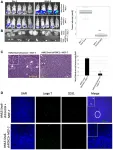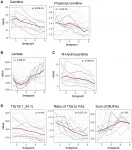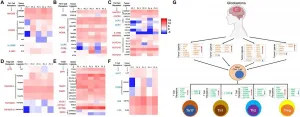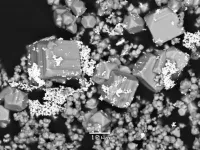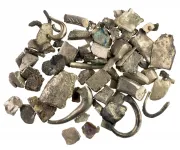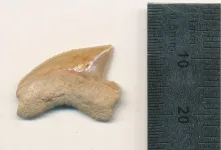(Press-News.org) Research published today has demonstrated the viability of 3D-printed tissue scaffolds that harmlessly degrade while promoting tissue regeneration following implantation.
The scaffolds showed highly promising tissue-healing performance, including the ability to support cell migration, the 'ingrowth' of tissues, and revascularisation (blood vessel growth).
Professor Andrew Dove, from the University of Birmingham's School of Chemistry, led the research group and is the lead author on the paper published in Nature Communications, which characterises the physical properties of the scaffolds, and explains how their 'shape memory' is key to promoting tissue regeneration.
Professor Dove commented: "The scaffolds have evenly distributed and interconnected pores that allow diffusion of nutrients from surrounding tissues. The shape memory means this structure is retained when the scaffold is implanted into tissues, and this supports the infiltration of cells into the scaffold while encouraging tissue regeneration and revascularisation."
The scaffolds were created using 3D printing resin 'inks' developed during a major programme of biomaterials research led by Professor Andrew Dove at the University of Birmingham and Warwick University. The resins are being commercialised under the tradename 4Degra™ by 4D Biomaterials, a spinout from University of Birmingham Enterprise and Warwick Innovations that was launched in May 2020.
The scaffolds showed several major advantages over current approaches used to fill soft tissue voids that remain after trauma or surgery, including sufficient elasticity to conform to irregular spaces, the ability to undergo compression of up to 85% before returning to their original geometry, compatibility with tissues, and non-toxic biodegradation.
The paper describes several compositions for the 4Degra™ resins that enable materials of a wide range of strengths to be manufactured. All of the compositions include a photoinitiator and a photoinhibitor to ensure the resins rapidly turn into gel on exposure to light in the visible spectrum to enable their 3D printing into a range of scaffold geometries.
The researchers showed that the materials were non toxic to cells and they also performed mechanical testing to ensure the scaffolds could regain their shape, geometry and pore size after compression, and performed tests that showed the scaffolds can fill an irregular shaped void in alginate gel which was used as a mimic of soft tissue.
Laboratory studies demonstrated that the scaffold degrades by surface erosion into non-acidic products, which means the scaffold structure allows for slow, continuous tissue infiltration.
The findings were confirmed in a mouse model that simulates implantation into adipose (fat) tissue. These studies showed infiltration of adipocytes and fibroblasts and vascularisation at two months, and a tissue arrangement and macrophage presence that was indicative of normal tissue restoration rather than damaged, scarred tissue or an inflammatory response.
At four months, the researchers found small, mature blood vessels in the surrounding tissue. The scaffolds also demonstrated excellent biocompatibility. The collagen capsule formed around implants was less than 200 μm thick, which is well below the 500 μm threshold used for biocompatibility in other studies, and there was no calcification or necrosis.
Also at four months, 80% of the scaffold was still present, demonstrating the slow degradation predicted by the laboratory studies, and indicating the scaffolds would provide support for more than a year, allowing sufficient time for mature tissue ingrowth. The controls, which used poly(L-lactic acid) (PLLA) as a comparator, did not show a significant reduction over the four month period.
Professor Dove comments: "3D printed materials have received a lot of attention in the tissue engineering world. However void-filling materials to provide mechanical support, biocompatibility, and surface erosion characteristics that ensure consistent tissue support during the healing process, and this means a fourth dimension (time) needs to be considered in material design.
"We have demonstrated that it's possible to produce highly porous scaffolds with shape memory, and our processes and materials will enable production of self-fitting scaffolds that take on soft tissue void geometry in a minimally invasive surgery without deforming or applying pressure to the surrounding tissues. Over time, the scaffold erodes with minimal swelling, allowing slow continuous tissue infiltration without mechanical degradation."
4D Biomaterials has made fast progress in scaling up production of the 4Degra™ resin-inks at its laboratory in MediCity, Nottingham (UK) and is now offering technical grade material for commercial supply to 3D printing companies and medical device manufacturers.
CEO Phil Smith said "We are looking to collaborate with innovative companies in Europe and North America to develop a new generation of 3D-printed medical devices that translate the unique advantages of the 4Degra™ resin-ink platform into improved treatment outcomes for patients". With the first customer shipments dispatched and a funding round about to close, Phil added "We will be making further announcements shortly."
INFORMATION:
For further media information, interviews or an embargoed copy of the paper contact Tony Moran, University of Birmingham, email t.moran@bham.ac.uk or +44 (0) 7827 832312
For further commercial or investment information contact Philip Smith, 4D Biomaterials, e-mail p.smith@4dbiomaterials.co.uk.
PHOTO CAPTION - please credit University of Birmingham:
* 4D resins can print bioresorbable tissue scaffolds
Notes to editors:
Dove et al (2020). 4D Polycarbonates via Stereolithography as Scaffolds for Soft Tissue Repair is published in Nature Communications
About 4D Biomaterials
4D Medicine Ltd (trading as 4D Biomaterials) was founded by a team of world class chemists and engineers to develop and commercialise a novel range of patent-pending, printable resins that promise to transform outcomes for patients across a range of biomedical applications.
About University of Birmingham Enterprise
University of Birmingham Enterprise helps researchers turn their ideas into new services, products and enterprises that meet real-world needs. We also support innovators and entrepreneurs with mentoring, advice, and training and manage the University's Academic Consultancy Service.
About Warwick Innovations
Warwick Innovations is the knowledge exchange and commercialisation arm of the University of Warwick. It provides business expertise, IP protection, support services and funding to the University's academic innovators from any discipline. It designs and delivers enterprise training programmes for researchers at all stages of their career development.
About the University of Birmingham
The University of Birmingham is ranked amongst the world's top 100 institutions. Its work brings people from across the world to Birmingham, including researchers, teachers and more than 6,500 international students from over 150 countries.
Flies have discriminating taste. Like a gourmet perusing a menu, they spend much of their time seeking sweet nutritious calories and avoiding bitter, potentially toxic food. But what happens in their brains when they make these food choices?
Yale researchers discovered an interesting way to find out. They tricked them.
In a study that could also help illuminate how people make food choices, the researchers gave hungry fruit flies the choice between sweet, nutritious food laced with bitter quinine and a less sweet, but not bitter, food containing fewer calories. Then, using neuroimaging, they tracked neural activity in their brains as they made these tough choices.
So which won? Calories or better taste?
"It depends on how hungry they are," said Michael Nitabach, professor of ...
Researchers at Uppsala University have discovered lymph node-like structures close to the tumour in brain cancer patients, where immune cells can be activated to attack the tumour. They also found that immunotherapy enhanced the formation of these structures in a mouse model. This discovery suggests new opportunities to regulate the anti-tumour response of the immune system.
Glioma is a deadly brain tumour with a dismal prognosis. One reason why brain tumours are very hard to treat is that our immune system, which is designed to detect and destroy foreign ...
Although most Canadians die from predictable causes and have health needs that can be met at home, only 20% of people receive a physician home visit in their last year of life.
To help understand the changing care needs of older adults as they age and when they might be nearing the end of their lives, a team of researchers developed the Risk Evaluation for Support: Predictions for Elder-Life in the Community Tool (RESPECT).
The calculator, which predicts death within 6 months, is based on data from more than 491 000 community-dwelling older adults who used home care in the 6-year period between 2007 and 2013.
"The RESPECT calculator allows families and their loved ...
Oncotarget published "Carcinoma cells that have undergone an epithelial-mesenchymal transition differentiate into endothelial cells and contribute to tumor growth" which reported that the authors investigated whether EMT can confer endothelial attributes upon carcinoma cells, augmenting tumor growth and vascularization.
Hypoxic regions, demarcated by HIF-1α staining, exhibited focal areas of E-cadherin loss and elevated levels of vimentin and the EMT-mediator FOXC2. Implantation of MCF-7 cells, co-mixed with human mammary epithelial cells overexpressing the EMT-inducer Snail, markedly ...
Oncotarget published "Perioperative changes in the plasma metabolome of patients receiving general anesthesia for pancreatic cancer surgery" which reported that little is known about the impact of anesthesia on the plasma metabolome, although many metabolites have been shown to modulate the function of various immune cells, making it particularly interesting in the context of oncological surgery.
In this study longitudinal dynamics in the plasma metabolome during general anesthesia in patients undergoing pancreatic surgery were analyzed.
Prospective, observational study with 10 patients diagnosed with pancreatic malignancy and subjected to elective resection surgery under general anesthesia.
Plasma metabolites were quantified at ...
Oncotarget published "Genome wide DNA methylation landscape reveals glioblastoma's influence on epigenetic changes in tumor infiltrating CD4+ T cells" which reported that whole-genome bisulfite sequencing of tumor infiltrating and blood CD4 T-cell from GBM patients showed 13571 differentially methylated regions and a distinct methylation pattern of methylation of tumor infiltrating CD4 T-cells with significant inter-patient variability.
The methylation changes also resulted in transcriptomic changes with 341 differentially expressed genes in CD4 tumor infiltrating T-cells compared to blood.
Analysis of specific genes involved in CD4 differentiation and function revealed differential methylation status of TBX21, GATA3, RORC, FOXP3, IL10 and ...
Inadequate exposure to UVB light from the sun may be associated with an increased risk of colorectal cancer, particularly in older age groups, according to a study using data on 186 countries, published in the open access journal BMC Public Health.
Researchers at the University of California San Diego, USA investigated possible associations between global levels of UVB light in 2017 and rates of colorectal cancer for different countries and age groups in 2018.
The authors found that lower UVB exposure was significantly correlated with higher rates of colorectal cancer across all ...
Why are gold deposits found at all? Gold is famously unreactive, and there seems to be little reason why gold should be concentrated, rather than uniformly scattered throughout the Earth's crust. Now an international group of geochemists have discovered why gold is concentrated alongside arsenic, explaining the formation of most gold deposits. This may also explain why many gold miners and others have been at risk from arsenic poisoning. This work is presented at the Goldschmidt conference, after recent publication*.
Gold has been prized for millennia, for its purity and stability. It's also rare enough to retain its value - the World Gold Council estimates that all the gold ever mined in the world would fit into a 20x20x20-meter cube. It is valued for its beauty, but also because it ...
Scientists have reconstructed the Eastern Mediterranean silver trade, over a period including the traditional dates of the Trojan War, the founding of Rome, and the destruction of Solomon's Temple in Jerusalem. The team of French, Israeli and Australian scientists and numismatists found geochemical evidence for pre-coinage silver trade continuing throughout the Mediterranean during the Late Bronze and Iron Age periods, with the supply slowing only occasionally. Silver was sourced from the whole north-eastern Mediterranean, and as far away as the Iberian ...
Scientists have found an unexplained cache of fossilised shark teeth in an area where there should be none - in a 2900 year old site in the City of David in Jerusalem. This is at least 80 km from where these fossils would be expected to be found. There is no conclusive proof of why the cache was assembled, but it may be that the 80 million-year-old teeth were part of a collection, dating from just after the death of King Solomon*. The same team has now unearthed similar unexplained finds in other parts of ancient Judea.
Presenting the work at the Goldschmidt Conference, lead researcher, Dr. Thomas Tuetken (University of Mainz, Institute of Geosciences) said:
"These fossils are not in their original setting, so they have been moved. They were probably valuable to someone; ...
